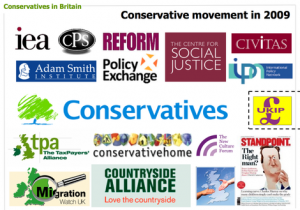Difference between revisions of "Movement conservatism"
(→Britain) |
|||
| Line 1: | Line 1: | ||
[[Movement Conservatism]] has been described by [[Paul Krugman]] as "the potent alliance of wealthy individuals, corporate interests and the religious right that took shape in the 1960s and 1970s."<ref>Paul Krugman, [http://select.nytimes.com/2006/11/10/opinion/10krugman.html?_r=1 The Great Revulsion], New York Times, 10 November 2006.</ref> | [[Movement Conservatism]] has been described by [[Paul Krugman]] as "the potent alliance of wealthy individuals, corporate interests and the religious right that took shape in the 1960s and 1970s."<ref>Paul Krugman, [http://select.nytimes.com/2006/11/10/opinion/10krugman.html?_r=1 The Great Revulsion], New York Times, 10 November 2006.</ref> | ||
| + | [[File:Picture 12.png|right|thumb|300px|Slide produced by [[Matthew Elliott]] of the [[Taxpayers Alliance]] to illustrate the [[Conservative movement]] in the UK in 1997]] | ||
| + | [[File:Picture 11.png|right|thumb|300px|Slide produced by [[Matthew Elliott]] of the [[Taxpayers Alliance]] to illustrate the [[Conservative movement]] in the UK in 2009]] | ||
==Britain== | ==Britain== | ||
In Britain, [[Tim Montgomerie]], has described the conservative movement as "the infrastructure outside of the party that supports small 'c' conservative values."<ref>Tim Montgomerie, [http://conservativehome.blogs.com/centreright/2009/03/the-growth-of-b.html The growth of Britain's conservative movement], ConservativeHome, 14 March 2009.</ref> | In Britain, [[Tim Montgomerie]], has described the conservative movement as "the infrastructure outside of the party that supports small 'c' conservative values."<ref>Tim Montgomerie, [http://conservativehome.blogs.com/centreright/2009/03/the-growth-of-b.html The growth of Britain's conservative movement], ConservativeHome, 14 March 2009.</ref> | ||
Revision as of 15:50, 19 August 2011
Movement Conservatism has been described by Paul Krugman as "the potent alliance of wealthy individuals, corporate interests and the religious right that took shape in the 1960s and 1970s."[1]

Slide produced by Matthew Elliott of the Taxpayers Alliance to illustrate the Conservative movement in the UK in 1997

Slide produced by Matthew Elliott of the Taxpayers Alliance to illustrate the Conservative movement in the UK in 2009
Britain
In Britain, Tim Montgomerie, has described the conservative movement as "the infrastructure outside of the party that supports small 'c' conservative values."[2]
A March 2009 presentation by Montgomerie and Matthew Elliott listed a number of organisations as part of the British conservative movement:
- Institute of Economic Affairs | Centre for Policy Studies | Reform | Adam Smith Institute | Policy Exchange | Centre for Social Justice | Civitas | International Policy Network | Taxpayers' Alliance | ConservativeHome | New Culture Forum | Standpoint | Migration Watch UK | Countryside Alliance | Centre for Social Cohesion[3]
Elliott's slides (pictured right) compared this with the smaller size of the movement in 1997. According to Montgomerie the comparison was intended to be indicative rather than comprehensive.[3]
Notes
- ↑ Paul Krugman, The Great Revulsion, New York Times, 10 November 2006.
- ↑ Tim Montgomerie, The growth of Britain's conservative movement, ConservativeHome, 14 March 2009.
- ↑ 3.0 3.1 Tim Montgomerie, The growth of Britain's conservative movement, ConservativeHome, 14 March 2009.